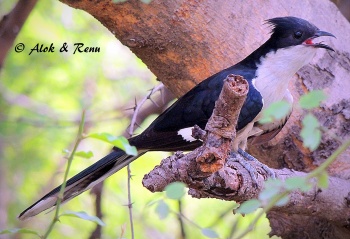Alternative name: Pied Cuckoo; Pied Crested Cuckoo; Black-and-white Cuckoo
- Clamator jacobinus
Oxylophus jacobinus
Identification
34 cm. (13½ in) A distinctive cuckoo.
- Glossy black upperparts with a prominent crest
- White patch on black wings and white tips to black tail
- White underparts
- Long graduated tail
- serratus has two colour morphs, one greyish white to white below with streaked throat, the other (mainly in coastal southern Africa) all glossy black with white wing patch and without white in tail
Juveniles are browner above and yellowish-white below.
Distribution
Found in most of Africa south of the Sahara and on the Indian Subcontinent.
Recorded in Saudi Arabia, Oman and the Seychelles on migration.
Generally common or not uncommon throughout much of its large breeding range.
Taxonomy
A member of the order Cuculiformes, which also includes the Roadrunners and the Anis.
It is sometimes placed in the genus Oxylophus.
Subspecies
Clamator jacobinus has three subspecies[1]:
- C. j. jacobinus in southern India and Sri Lanka
- C. j. pica in sub-Saharan Africa south to Tanzania and Zambia, and northwest India to Nepal and Burma, occasionally southern Tibet.
- C. j. serratus in southern Africa
Habitat
Scrub, wetlands and cultivation. In India mainly in lowlands and hills up to 2000m, in Africa up to 3000m, but mainly below 1500m.
Behaviour
Breeding
It is a brood parasite. Lays its eggs mainly in the rainy season.
Hosts are mainly Turdoides babblers like Common Babbler, Large Grey Babbler, Jungle Babbler, Fulvous Chatterer and Rufous Chatterer. Also Bulbuls (like Cape Bulbul) and Fiscal Shrike.
Diet
Diet includes a variety of insects and caterpillars. Takes also eggs of host birds and berries.
Forages mainly in trees and bushes, descends also to the ground.
Vocalisation
It is a noisy species, with a persistent and loud pipew pipew pipew and pew pew call.
Listen in an external program
Recording by Alok Tewari
Keoladeo National Park, India, July-2016
Two types of calls/song, long and short given by one individual, sitting on a bough of Acacia tree, on the margin of the wetland.
Movements
A migrating species. An intra-African migrant, arriving in breeding areas with rains and abundance of food (eg caterpillars). Nominate birds from India winter in East and Central Africa.
References
- Clements, J. F., T. S. Schulenberg, M. J. Iliff, S. M. Billerman, T. A. Fredericks, B. L. Sullivan, and C. L. Wood. 2019. The eBird/Clements Checklist of Birds of the World: v2019. Downloaded from http://www.birds.cornell.edu/clementschecklist/download/
- Del Hoyo, J, A Elliot, and J Sargatal, eds. 1997. Handbook of the Birds of the World. Volume 4: Sandgrouse to Cuckoos. Barcelona: Lynx Edicions. ISBN 978-8487334221
Recommended Citation
- BirdForum Opus contributors. (2024) Jacobin Cuckoo. In: BirdForum, the forum for wild birds and birding. Retrieved 26 April 2024 from https://www.birdforum.net/opus/Jacobin_Cuckoo
External Links








